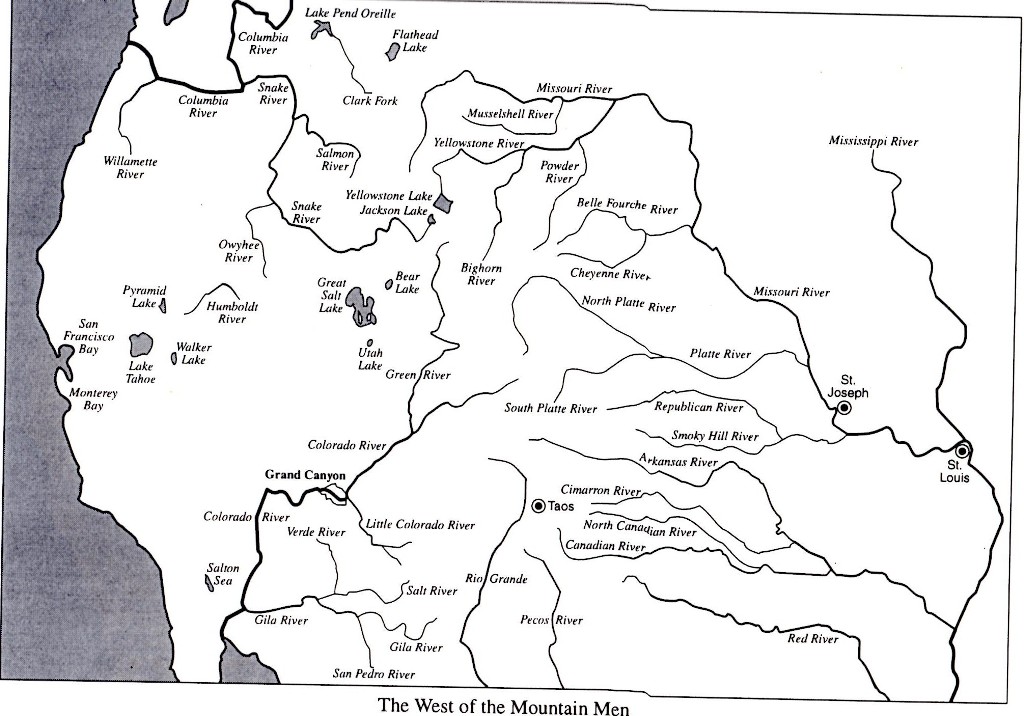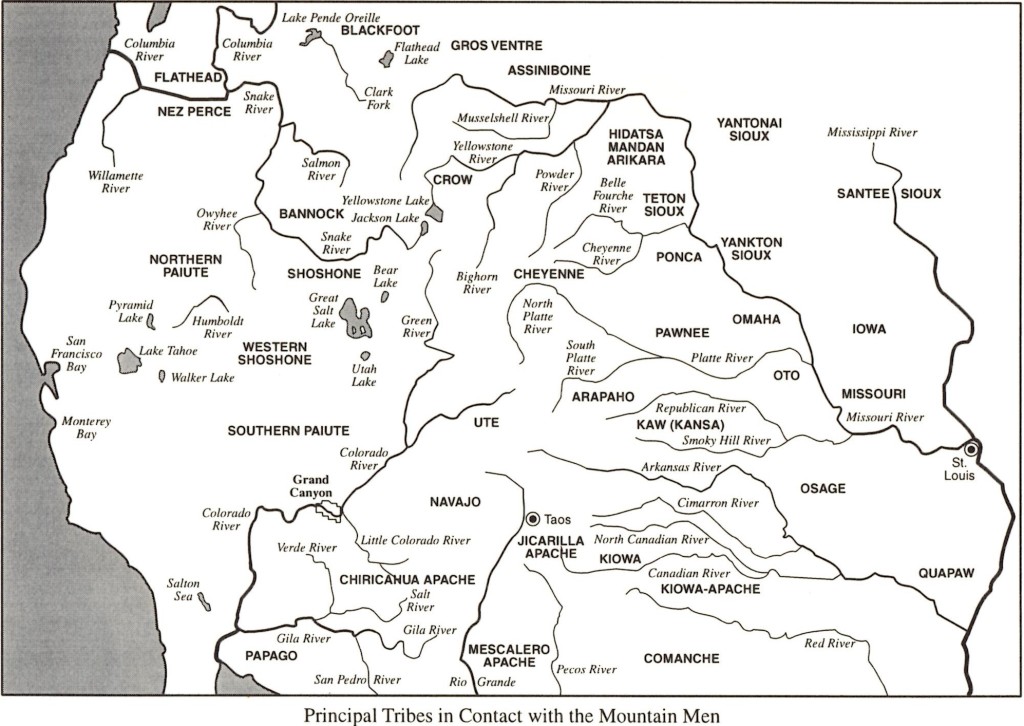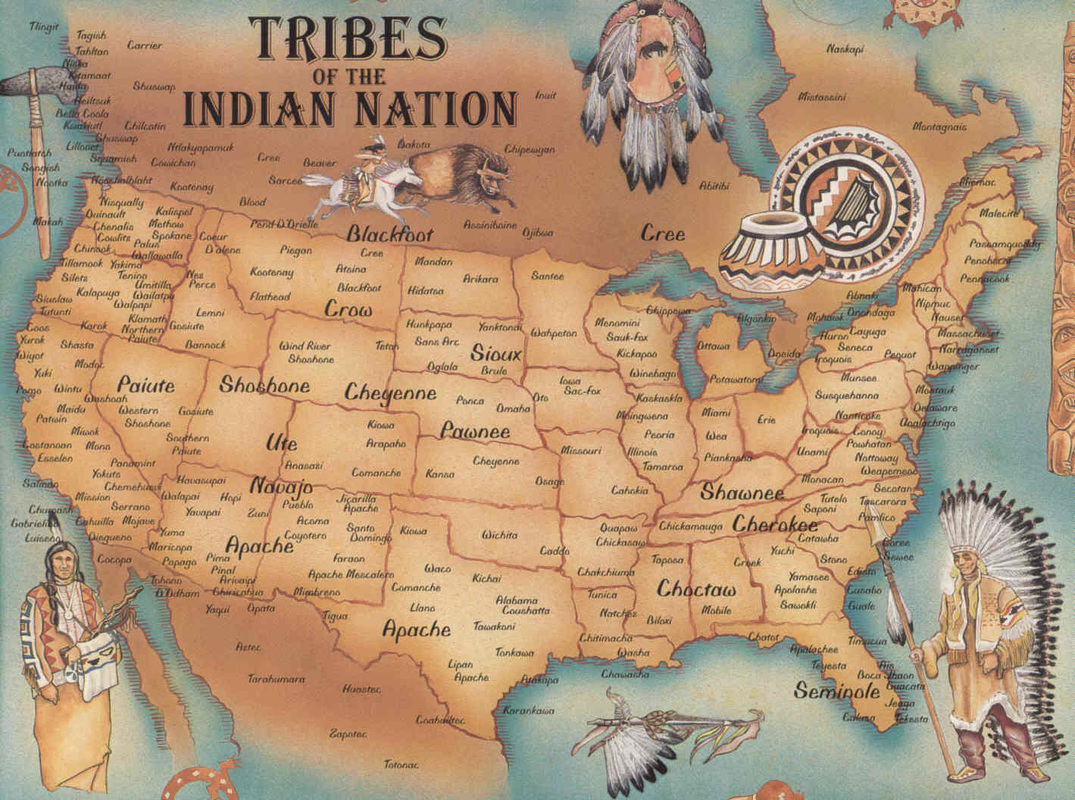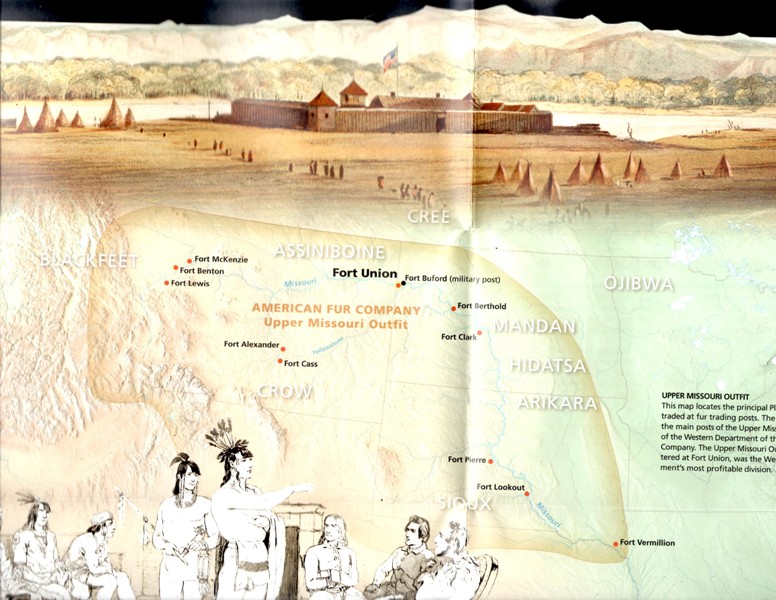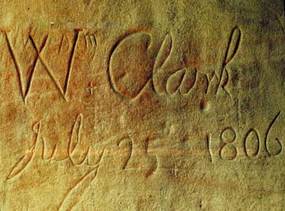
The reason I did that is because so many of you were coming to this site to read about the various fur trappers and mountain men I’d profiled in my book Tribes and Trappers.
I knew that another post profiling books would be a good idea, but the problem was that I wasn’t researching that period.
That’s changed now, as I’ve been writing novels about John Colter.
To make those novels more interesting, I’ve gone back to the secondary source material. These are the books that you’re interested in, for they tell the tale of the Upper Missouri Fur trade.
More than that, however, they talk about the 1820s and 1830s rendezvous, what guns the mountain men had, what supplies they carried, and a whole lot more.
Probably one of the best features of the books are the maps. I’ve scanned many of them, and you’ll see them as we profile the books.
Fur trapping was the economic stimulus that allowed America to discover and open up the West. Discover what that was like in these great mountain men fur trapping books!
Prologue to Lewis and Clark
|
|
Prologue to Lewis and Clark: The Mackay and Evans Expedition was written by W. Raymond Wood in 2003.
Like many fur trapping books, it hails from the University of Oklahoma Press. |
You see, I’ve started in on a detailed timeline of the American fur trade in the 1700s and 1800s. Books like this fill in a lot of that missing information from before Lewis and Clark.
Wow, I got what I was looking for and I got a lot more. The book does a great job profiling the Indian trading system that existed on the Upper and Lower Missouri in the 1700s.
You get a good look at La Vandyre, the French explorer that came through the Mandan Villages in the 1730s. St. Louis is also profiled in detail, with the 1790s discussed most.
Hey, that’s only the first 50 pages or so of this 200-page book. If you’re interested in fur trapping before Lewis and Clark, this is a good one to check out.
Before Lewis and Clark
|
|
I loved this book when I got it from the library.
The full title is Before Lewis and Clark: The Story of the Chouteaus, the French Dynasty That Ruled America’s Frontier. |
You get a lot more than that, though. The book really is a detailed biography of the Chouteau family. That family founded St. Louis in early 1764.
That’s really where this story starts, in the 1760s. You’ll move on from there, getting a look at the French and Spanish control of the area. After that the Americans take charge and you’ll get lots of details about Lewis and Clark and what they were doing after the expedition.
The book ends in the 1850s, covering about three generations of the Chouteau family. All the while you get a look at the Upper Missouri, the beginning of the American fur trade, and its end.
This is a great book and I highly suggest you get it at the library or buy a used copy. New copies are pretty pricey. Whatever you do, don’t miss this fun tale and wealth of factual information.
After Lewis and Clark
|
|
Robert M. Utley wrote After Lewis and Clark: Mountain Men and the Paths to the Pacific in 1997.
It’s a good book, but you have to realize, it really doesn’t tell you a whole lot about the time directly after Lewis and Clark. |
Well, that’s not completely true. You get two chapters that profile Colter and Drouillard up to the 1810s and then he profiles the “doomed trio” of Robinson, Hoback, and Reznor. If you haven’t heard the story of how they were killed and a young woman escaped with two children, it’s worth checking out.
After that we go right up to 1822 and Jedediah Smith. You get two chapters on him and then we move up to Etienne Provost in the 1830s.
Then it’s back to Smith for a time. Really, the book takes a biographical approach to its subject, like many mountain man fur trapper histories do.
You get some of the lesser-mentioned mountain men in this book, and the chapter on Thomas Fitzpatrick taking the missionaries to Oregon is a good one.
If you want a book that takes you past the Ashley’s Hundred days, this is a good one. There’s not a whole lot new, but it was put out about twenty years after the last round of fur trapping books. For that reason alone it should have a longer introduction.
Professional historians – they’re often too busy teaching classes to teach posterity. Oh well.
Firearms, Traps, & Tools of the Mountain Men
|
|
Firearms, Traps, & Tools of the Mountain Men was written by Carl P. Russell in 1967.
It’s a monster book, with more than 400 pages. |
I never would have found it without searching for mountain man guns. That’s what you get a lot of in the book, and it goes into great detail on the pistols and flintlocks and rifles the men carried, all the way from Lewis and Clark to the 1850s or so.
The book’s subtitle is “A guide in picture & text to the equipment of the trappers and fur traders who opened the Old West from the 1820s to the 1840s.”
Russell started working on the book in 1830 and he worked on it for quite a few years. There’s a good introduction explaining this.
It’s hard to go over all this book holds. The sketches are wonderful, there’s a detailed inventory of Astor’s inventory from 1814, and you even get an idea of how forts were constructed and what the look like.
Honestly, if you’re interested in fur trapping and mountain man books, this bad boy needs to be on your shelf at home!
A Rendezvous Reader
|
|
A Rendezvous Reader: Tall, Tangled, and True Tales of the Mountain Men, 1805-1850 was written by several authors.
You see, the book is an anthology of essays pretty much, though they’re more anecdotes and stories really. |
That’s because you often get the words directly from the mouth of the mountain men and fur trappers, or at least someone that talked to them and wrote it down.
There are more than 150 chapters in 12 sections in this 300-page book. Most of the stories are short, and James H. Maguire, Peter Wild, and Donald A. Barclay did a good job editing it.
The book came out in 1997 and it’s well worth a look. I was happy to come across it because it gave me some interesting ideas. What were those ideas?
- Drinking from a dead buffalo;
- Using a heated gun barrel to cauterize an arrow wound;
- What the inside of Fort Laramie looked like;
- The actual ad Ashley put in the St. Louis papers in 1822;
- The various animals that the fur trappers encountered.
Wow, that’s some fun stuff, huh? Honestly, this book is interesting but it can be a little dry at places. What saves it are the short chapters, some only a few paragraphs long.
That means you can breeze through the book, and pick it up and start reading just about anywhere. Another great value is the maps.
Yes, this book has some of the best maps I’ve seen! Check ‘em out:
Rocky Mountain Rendezvous
|
|
I profiled this book before, but I don’t think I did that good of a job. Let’s fix that.
This book came out in 1985. The full title of this book is Rocky Mountain Rendezvous: A History of the Fur Trade Rendezvous, 1825-1840. |
Yeah, it’s the 1825 Randevouze Creek Rendezvous and Gowan tells us that coffee was $1.50 a pound (the same as sugar), fish hooks were $1.50 a dozen, and tobacco cost $3 a pound.
Before that he mentions the exact items cached at Bridger Bottom, “six miles below Buckboard Wash and fourteen miles above Henry’s Fork.” Some of those things were:
- 3 packs of powder;
- Horse shoes;
- 1 pack with 7 dozen knives;
- 2 peaces scarlett Cloth.
Boy, it doesn’t get much more detailed than that. There are images and maps and tons of details in this book.
I would highly recommend checking out the Table of Contents on Amazon, because it lists the places and year of all the major mountain man rendezvouses from 1825 to 1840.
What you’ll like most of all are the stories. You get long quotes from the time. Men talk about getting to the locations, the horses they had, the things they brought, and the mayhem they caused…, er, I mean fun, the fun they had.
You’ll also get a good look at how the companies robbed these hardworking Americans blind. Yep, the plied them with liquor and took their goods, often leaving them in debt when they went back out again.
Nearly always the books will say that the mountain men didn’t really mind, and that they lived for the once-a-year bash.
That may be the case, but I feel some of the men were resentful of what took place, or at least resentful of their own problems with alcohol. It’s a mixed bag, and both parties are equally to blame.
Perhaps one day we’ll get a more balanced history. Until then, this book does one helluva job!
The Fur Trade of the American West, 1807-1840
|
|
David J. Wishart wrote this book in 1979. The subtitle is “A Geographical Synthesis.”
Yes, Wishart was a professor of geography at the University of Nebraska. |
This book really delves into the economics of the fur trade. It also talks a lot about the mountain man fur trapping strategy, both before and after the rendezvous started up.
The book confines itself to the 1810s, 1820s and 1830s for the most part. You will get into the 1810s, but not so much. The closing synopses chapters is a good rundown on the whole fur trade.
This was a great find, and it’s really short book, with just 210 pages or so. It’s a good read and will increase your knowledge of fur trapping history a lot. Definitely one of my favorites!
Manuel Lisa and the Opening of the Missouri Fur Trade
|
|
Richard Edward Oglesby wrote this wonderful book in 1963 and it was released by the University of Oklahoma Press.
It’s essentially a biography of Manuel Lisa and I loved it. I was surprised that the man had done so much before he even got to St. Louis in 1798! |
You get a lot of correspondence between Lisa and Pierre Menard in 1809, for instance, and this is how we get amazing facts like:
- Vasquez knew of a trapper named Case Fortin that had had 20 packs of furs the year before, though that may have grown to 50. It was suspected the man had crossed the Divide to winter with the Flathead Indians.
- 13 keelboats and barges left St. Louis in all for the 1809-10 expedition, and they did so in two groups. The first group had 160 men and 190 men were in the second. About 80 hunters went in advance of the groups.
- On May 3 F. Regnier and Company provided $6,171.14 in goods for the expedition and Pierre Chouteau provided £6,861 pounds sterling. That last showed that the goods had come from Montreal, perhaps before the Embargo Act of 1807, though knowing Pierre, perhaps after.
Those are just some snippets from about a 10-page stretch of the 200-page book. I know you’ll want to give it a look.
The Fur Trade on the Upper Missouri, 1840-1865
|
|
You don’t often see books detailing fur trapping after 1840, but this book does a marvelous job of it.
Well, it gives you lots of information, but it’s a bit dry. |
Right away author John E. Sunder mentions how the major works on fur trappers don’t extend past the 1840s. He means to remedy that, and he does a good job.
I’ll admit that I haven’t read this book, I’ve just flipped through it. I’m not that far into the fur trade yet where this period interests me.
Maybe you’re different. After all, many men were dependent upon the trade. Just because fashion trends had changed didn’t mean people were going to stop what they loved to do, or needed to do. And that was trap beaver.
The book starts off in 1837 and 1838 and focuses on Pierre Chouteau, Jr. This would be the man that had a large involvement on the Upper Missouri in the years before Montana became a territory.
You’ll get that history with lots of names and dates and everything else. I will say that the book is a bit dry and more scholarly. Yeah, this was before anyone cared about writing for the popular audience.
One highlight for me are the steamboats that were plying the river at this time, all the way up to the Upper Missouri of today’s Montana. You’ll get quite a few names, dates, and locations.
The book is a bit dry but history buffs will enjoy it, for as Sunder says, there’s not much on this period.
Across the Wide Missouri
|
|
Across the Wide Missouri was written by Bernard DeVoto in 1947 and won the Pulitzer Prize for History.
DeVoto was a historian of the West and he also wrote novels. |
I have not read this book though I have read a bit of his other great book, The Course of Empire. That book came out in 1952 and really goes back to the 1500s and 1600s before moving up to the fur trapping period of the 1800s toward the end.
Across the Wide Missouri keeps its focus on the 1830s, and particularly the years 1833-38.
I would encourage you to get an earlier version that has the Alfred Jacob Miller photographic pages in it. Those are great and you get wonderful captions. Newer versions of the book do not have these – I’ve compared them at the library and know this.
DeVoto profiles Miller and the man that hired him, William Drummond Stewart, who was a Scottish noble taking a sightseeing tour of the American West.
You’ll get a lot on mountain men of the time, including Thomas Fitzpatrick. There’s a lot on Indians too.
I just got this book from the library and I’m looking forward to reading it soon. I hope you are too.
The Course of Empire
|
|
Since we profiled a book that we’ve already profiled, let’s add one more to our list.
This is Bernard DeVoto’s The Course of Empire, which appeared in 1953. |
In case you haven’t noticed, I love the maps of this period, and I’ll be profiling them a lot more in the coming months. This book has 23 maps.
Until then, this book is good. It starts all the way back in the late-1400s and discusses the changes in Europe that allowed the New World to be discovered.
We look at the European powers and the routes of exploration they took. In that regard, this is a great book for figuring out how the British got up into Canada and remained there so long.
We don’t get up into Lewis and Clark until about 400 pages into the 600-page book.
This is a powerful historian at work here, one that many associate with the West. What really impressed me about this book were the Montana connections that DeVoto had.
He grew up in Utah but spent some time in Montana, as he mentions in the acknowledgements.
He talks about Elers Koch of Missoula who helped him follow the Lewis and Clark trail in 1946 and helped him find the Lolo Pass trail in 1951.
DeVot was friends with Joseph Kinsey Howard, Montana’s most popular historian, who published Montana: High, Wide, and Handsome in 1942.
“I am the poorer in that Joseph Kinsey Howard…cannot read what I have made of what…[he] taught me,” DeVoto says. Howard died in August 1951.
DeVoto would have made a good Montana historian, for he railed against corporations and mining trusts. He would have hated Anaconda Copper and probably did.
He was a historian of Montana, however, for he profiled the West. This book is the second in his trilogy of the West, which includes:
- The Year of Decision: 1846 (1943)
- Across the Wide Missouri (1947)
- The Course of Empire (1952)
I haven’t read these books, but I will someday. There’s a lot of time, and the fur trade of yesteryear isn’t going anywhere.
Conclusion
Many hail from the 1960s, which is what I call the third generation of fur trapping books.
- The first was in the 1800s, both around the time of the mountain men and directly after them.
- The second generation of mountain man histories came about in the early 1900s and into the 1940s.
- The third generation was the 1960s as we mentioned, with a smattering from the 1950s, and it went to the 1980s or so.
- Currently we’re in the fourth generation of mountain man fur trapping books, with those from the late-1980s through the 2010s.
I’m basing these assertions on the copyright dates of the books, the information I’ve gleaned from reading them, and the other research I’ve done.
I’ve been researching the fur trade since the spring of 2013 and I’ll continue to do so for some time.
The categories stretching from the 1810s to the 1850s on this site are quite bare. That’ll be fixed, and I hope you’re here to see it.
Thanks for reading!





